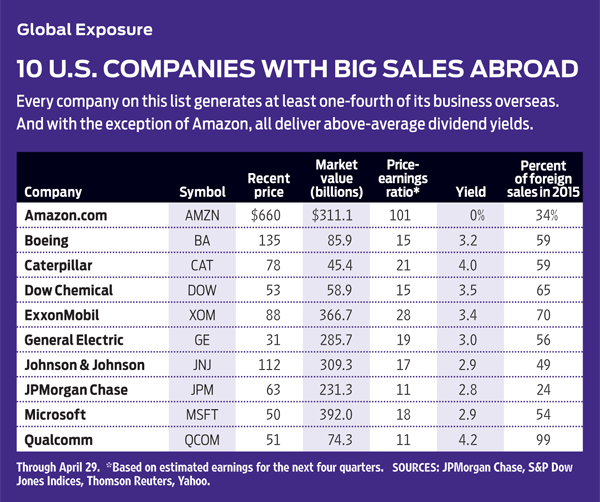10 Good U.S. Stocks to Play the Global Economy
You don't need to invest in foreign stocks to get exposure to the rest of the world.

It’s practically an article of faith that, just as investors need to have both large- and small-company stocks in their portfolios, they must own both domestic and foreign shares. A widely cited paper by economists Haim Levy and Marshall Sarnat made the case for overseas diversification 46 years ago by looking at the performance of markets from 1951 through 1967. But Europe and Japan were growing rapidly then as they recovered from World War II. Today, is it really necessary—or wise—for investors to stray from the U.S.?
Look at the recent past. Over the past five years through April 29, the Dow Jones Global ex-U.S. Total Stock Market index returned an average of 0.9% per year. That index is composed of 9,000 stocks from 75 countries, excluding the U.S. Meanwhile, the Dow Jones U.S. Total Stock Market index, which tracks the entire domestic market, returned 10.5% annualized.
Go back further. Vanguard Total International Stock (symbol VGTSX) is an index mutual fund with holdings in about 5,000 foreign stocks, allocated among Europe (49%), Asia (41%) and the Americas (10%). If you had invested $10,000 in the fund 10 years ago, you would have a mere $11,716 today, compared with $19,279 if you had invested in Vanguard 500 Index (VFINX), which tracks Standard & Poor’s 500-stock index. Since its inception 20 years ago, Total International has registered a piddling annualized return of 4.2%. Vanguard 500 has returned an average of 7.8% per year.
From just $107.88 $24.99 for Kiplinger Personal Finance
Become a smarter, better informed investor. Subscribe from just $107.88 $24.99, plus get up to 4 Special Issues

Sign up for Kiplinger’s Free Newsletters
Profit and prosper with the best of expert advice on investing, taxes, retirement, personal finance and more - straight to your e-mail.
Profit and prosper with the best of expert advice - straight to your e-mail.
Higher risk usually means higher reward, but that hasn’t been the case with foreign stocks. Their paltry profits have been produced with what Vanguard’s own measures conclude is the highest “risk potential.” Morningstar ranks Total International’s volatility over the past 10 years as “above average.” Despite the low-return, high-risk profile, the fund is enormously popular, with some $200 billion in assets. Apparently, commentators (including me!) have persuaded investors that they must own foreign stocks.
Perhaps the past two decades (not to mention the past five years) have been an anomaly. I’m a contrarian kind of guy—maybe foreign stocks will bounce back in the decades ahead. But the numbers have been so awful that ignoring them would simply be foolish.
Home-field advantages. What the poor returns of foreign stocks indicate is that overseas companies themselves simply don’t perform as well as U.S. concerns. The U.S. accounts for just 5% of the world’s population and 16% of the world’s total economic output (based on purchasing-power parity, or what a currency can actually buy). But when it comes to profitability, size and management skill, American companies rule the world.
For example, in technology, the most dynamic global sector, eight of the world’s nine largest companies—based on a Forbes index that factors in revenues, profits, assets and market value—are headquartered in the United States. (The exception is Samsung, of South Korea.) The U.S. is home to 14 of the 30 largest consumer-goods companies and five of the eight largest energy companies—in both cases, far more than any other country.
Candidates seeking their parties’ presidential nominations have stressed the supposed decline of American manufacturing. Yes, China, with four times our population, replaced the U.S. as the world’s largest producer of goods in 2010. But the U.S. manufactures as much as the next three countries—Japan, Germany and South Korea—combined. More important to investors, U.S. manufacturers are becoming more efficient than their Asian rivals. In an article last December, IndustryWeek magazine projected that in 2020 the U.S. would be the “most competitive nation in the world” for manufacturing because of our “investment in research, technology, and innovation.”
There are also a couple of potential catalysts that could drive up domestic stocks. The U.S. has the highest corporate tax rates in the developed world, plus a system that taxes profits outside the country. My guess is that corporate tax reform will be on the agenda no matter who wins the presidential election, and U.S. businesses, which are already highly competitive because of substantial capital investment and good management, will do even better. Another possible change for the better: U.S. companies have thrived over the past five years despite a rising dollar for most of that period, which makes our goods more expensive to foreigners. The dollar has been falling steadily since November. Imagine if that trend continues for an extended period.
Meanwhile, European and Japanese companies are especially burdened by a deeply entrenched regulatory culture, and the Chinese haven’t fully liberated their firms from the Communist Party’s grip. The Chinese government’s goal of more employment and output is often at odds with the improvements in corporate productivity that investors seek.
The main risk to U.S. stocks’ edge over foreign stocks is that we will reject new trade deals. Killing the Trans-Pacific Partnership agreement, for example, would almost certainly harm large U.S. firms and allow Asian businesses to hunker down and sell to their own regional markets, which have an abundance of young consumers.
Overrated benefit. One reason advocates say to invest in foreign stocks is their lack of correlation to U.S. stocks. Stocks that are uncorrelated tend to move up and down independently of one another. By building a portfolio of uncorrelated assets, you get a smoother ride. For instance, if U.S. stocks take a big dive one year, foreign stocks may mitigate the damage by not losing as much, or even gaining. But the correlation between U.S. and foreign stocks is actually pretty tight compared with the correlation between U.S. stocks and other assets, such as commodities and Treasury bonds. Foreign stocks fared just as poorly as U.S. stocks during the sharp 2008 downturn.
Another reason to choose foreign stocks is that U.S.-based companies don’t reflect the entire global economy, and by investing internationally your portfolio tracks the world. But many U.S. companies already derive most of their revenues abroad. In fact, if you want your shares to reflect the entire planet, you can build a powerful 10-stock global portfolio with just U.S.-based companies. Try these: Amazon.com, Boeing, Caterpillar, Dow Chemical, ExxonMobil, General Electric, Johnson & Johnson, JPMorgan Chase, Microsoft and Qualcomm.
A study two years ago by the Vanguard Group found that although foreign stocks accounted for more than half of global market capitalization (that is, stock price times shares outstanding), U.S. investors put only about one-fourth of their total stock allocation in foreign companies. Vanguard’s point is that many Americans are overinvested in U.S. stocks, a phenomenon that economists call “home bias,” denoting an almost irrational leaning toward the homeland.
I’m not sure this prejudice is so bad. In light of actual results over the past few decades and the prospects for the years ahead, maintaining a bias in your portfolio toward U.S. stocks looks like an excellent strategy.

James K. Glassman, a visiting fellow at the American Enterprise Institute, is the author, most recently, of Safety Net: The Strategy for De-Risking Your Investments in a Time of Turbulence. Of the stocks mentioned, he owns Amazon.
Profit and prosper with the best of Kiplinger's advice on investing, taxes, retirement, personal finance and much more. Delivered daily. Enter your email in the box and click Sign Me Up.

-
 Changes Are Coming for This Invesco Bond Fund
Changes Are Coming for This Invesco Bond FundThe Invesco BulletShares 2026 Corporate Bond ETF's bonds will mature in 2026. Here's what investors should do.
-
 What Science Reveals About Money and a Happy Retirement
What Science Reveals About Money and a Happy RetirementWhether you’re still planning or already retired, these research-based insights point the way to your best post-work life.
-
 7 Retirement Planning Trends: What They Mean for You in 2026
7 Retirement Planning Trends: What They Mean for You in 2026From government shutdowns to market swings, the past 12 months have been nothing if not eventful. The key trends can help you improve your own financial plan.
-
 The Santa Claus Rally Officially Begins: Stock Market Today
The Santa Claus Rally Officially Begins: Stock Market TodayThe Santa Claus Rally is officially on as of Wednesday's closing bell, and initial returns are positive.
-
 'Humbug!' Say Consumers, Despite Hot GDP: Stock Market Today
'Humbug!' Say Consumers, Despite Hot GDP: Stock Market Today"The stock market is not the economy," they say, but both things are up. Yet one survey says people are still feeling down in the middle of this complex season.
-
 Stocks Rise to the Spirit of the Season: Stock Market Today
Stocks Rise to the Spirit of the Season: Stock Market TodayInvestors, traders and speculators are beginning to like the looks of a potential year-end rally.
-
 Nasdaq Leads as Tech Stages Late-Week Comeback: Stock Market Today
Nasdaq Leads as Tech Stages Late-Week Comeback: Stock Market TodayOracle stock boosted the tech sector on Friday after the company became co-owner of TikTok's U.S. operations.
-
 Cooler Inflation Supports a Relief Rally: Stock Market Today
Cooler Inflation Supports a Relief Rally: Stock Market TodayInvestors, traders and speculators welcome much-better-than-hoped-for core CPI data on top of optimism-renewing AI earnings.
-
 Nasdaq Sinks 418 Points as Tech Chills: Stock Market Today
Nasdaq Sinks 418 Points as Tech Chills: Stock Market TodayInvestors, traders and speculators are growing cooler to the AI revolution as winter approaches.
-
 Stocks Chop as the Unemployment Rate Jumps: Stock Market Today
Stocks Chop as the Unemployment Rate Jumps: Stock Market TodayNovember job growth was stronger than expected, but sharp losses in October and a rising unemployment rate are worrying market participants.
-
 Stocks Struggle Ahead of November Jobs Report: Stock Market Today
Stocks Struggle Ahead of November Jobs Report: Stock Market TodayOracle and Broadcom continued to fall, while market participants looked ahead to Tuesday's jobs report.